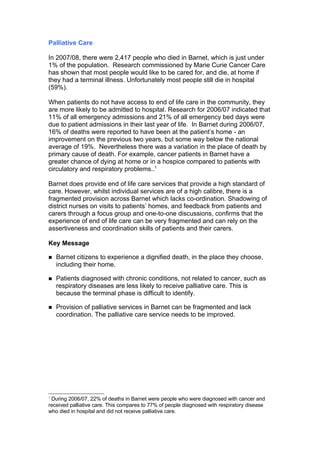Pallative Care
- 1. Palliative Care In 2007/08, there were 2,417 people who died in Barnet, which is just under 1% of the population. Research commissioned by Marie Curie Cancer Care has shown that most people would like to be cared for, and die, at home if they had a terminal illness. Unfortunately most people still die in hospital (59%). When patients do not have access to end of life care in the community, they are more likely to be admitted to hospital. Research for 2006/07 indicated that 11% of all emergency admissions and 21% of all emergency bed days were due to patient admissions in their last year of life. In Barnet during 2006/07, 16% of deaths were reported to have been at the patientâs home - an improvement on the previous two years, but some way below the national average of 19%. Nevertheless there was a variation in the place of death by primary cause of death. For example, cancer patients in Barnet have a greater chance of dying at home or in a hospice compared to patients with circulatory and respiratory problems..1 Barnet does provide end of life care services that provide a high standard of care. However, whilst individual services are of a high calibre, there is a fragmented provision across Barnet which lacks co-ordination. Shadowing of district nurses on visits to patientsâ homes, and feedback from patients and carers through a focus group and one-to-one discussions, confirms that the experience of end of life care can be very fragmented and can rely on the assertiveness and coordination skills of patients and their carers. Key Message Barnet citizens to experience a dignified death, in the place they choose, ïŪ including their home. Patients diagnosed with chronic conditions, not related to cancer, such as ïŪ respiratory diseases are less likely to receive palliative care. This is because the terminal phase is difficult to identify. Provision of palliative services in Barnet can be fragmented and lack ïŪ coordination. The palliative care service needs to be improved. 1 During 2006/07, 22% of deaths in Barnet were people who were diagnosed with cancer and received palliative care. This compares to 77% of people diagnosed with respiratory disease who died in hospital and did not receive palliative care.
